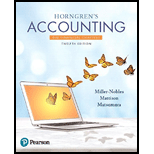
1)
Journal:
Accounts are debited to increase balances of assets and expenses and credited increase the balance of incomes and liabilities
To Prepare:
Journal Entries for November and December 2018.
2)
T- Account
It is a graphical representation of the postings made to the accounts during a reporting period.
It helps in analysis of the transactions impacting the accounts.
To Prepare:
T-Accounts for each of the entries.
3)
T-Account:
It is a graphical representation of the postings made to the accounts during a reporting period. It helps in analysis of the transactions impacting the accounts.
To indicate:
Posting to T-Accounts
4)
A trial Balance is a list of the balances of various Assets, Liabilities, Expense and Revenue Accounts. It helps in evaluating the arithmetical accuracy of financial transactions and postings during a reporting period and serves as the starting point in the preparation of financial statements.
To prepare:
Trial Balance as at 31 December 2018
5)
Financial Statements of an Entity
Financial Statements are financial records of the entities transactions for a given reporting period and indicate the financial health of an entity. They comprise of:
1. Income Statements,
2. Balance Sheets and,
3.
Prepare Income Statement for the year ended 31 December 2018.
6)
Statement of Owner’s Equity.
A statement of owner’s equity is a representation of all the capital introduced and withdrawn during a particular reporting period. It also represents the closing balance of the capital invested in a business.
To prepare:
Statement of Owner’s Equity for the year ended 31 December, 2018,
7)
Financial Statements of an Entity
Financial statements are financial records of the entities transactions for a given reporting period and indicate the financial health of an entity. They comprise of:
1. Income Statements,
2. Balance Sheets and,
3. Cash flow statements.
Balance Sheets list the closing balances of assets and liabilities after giving effect to the operations for a reporting period. Assets and liabilities are grouped together based on their nature and life.
To prepare:
8)
Debt Equity Ratio
It is a measure of the proportion of how much debt has been used to finance the equity and operations of the business.
The lower the ratio the better. Higher Debt equity ratio represents a highly leveraged business and can also indicate higher interest payments and lower profitability.
The Debt Ratio for the year ended 31 December 2018.
Want to see the full answer?
Check out a sample textbook solution
Chapter 2 Solutions
Horngren's Accounting, The Financial Chapters (12th Edition)
- Tyson manufacturing company produces and sells 120,000 units of a single product. Variable costs total $340,000 and fixed costs total $480,000. If each unit is sold for $12, what markup percentage is the company using? Right Answerarrow_forwardNonearrow_forwardWhat is the inventory turnover ratio?arrow_forward
- Can you help me with accounting questionsarrow_forwardOn January 1, Park Corporation and Strand Corporation had condensed balance sheets as follows: Items Current assets Noncurrent assets Total assets Current liabilities Long-term debt Stockholders' equity Total liabilities and equities Park $ 70,000 90,000 Strand $ 20,000 40,000 $ 60,000 $ 160,000 $ 30,000 $ 10,000 50,000 Ө 80,000 50,000 $ 160,000 $ 60,000 On January 2, Park borrowed $60,000 and used the proceeds to obtain 80 percent of the outstanding common shares of Strand. The acquisition price was considered proportionate to Strand's total fair value. The $60,000 debt is payable in 10 equal annual principal payments, plus interest, beginning December 31. The excess fair value of the investment over the underlying book value of the acquired net assets is allocated to inventory (60 percent) and to goodwill (40 percent). Required: On a consolidated balance sheet as of January 2, calculate the amounts for each of the following: a. Current assets b. Noncurrent assets c. Current…arrow_forwardProvide answer A B Carrow_forward
- Need help this question financial accountingarrow_forwardneed help this questions financial accountingarrow_forwardDirect materials used totaled $65,750; direct labor incurred totaled $199,400; manufacturing overhead totaled $344,800; Work in Process Inventory on January 1, 2004, was $186,100; and Work in Process Inventory on December 31, 2004, was $191,600. What is the cost of goods manufactured for the year ended December 31, 2004? Right Answerarrow_forward

 AccountingAccountingISBN:9781337272094Author:WARREN, Carl S., Reeve, James M., Duchac, Jonathan E.Publisher:Cengage Learning,
AccountingAccountingISBN:9781337272094Author:WARREN, Carl S., Reeve, James M., Duchac, Jonathan E.Publisher:Cengage Learning, Accounting Information SystemsAccountingISBN:9781337619202Author:Hall, James A.Publisher:Cengage Learning,
Accounting Information SystemsAccountingISBN:9781337619202Author:Hall, James A.Publisher:Cengage Learning, Horngren's Cost Accounting: A Managerial Emphasis...AccountingISBN:9780134475585Author:Srikant M. Datar, Madhav V. RajanPublisher:PEARSON
Horngren's Cost Accounting: A Managerial Emphasis...AccountingISBN:9780134475585Author:Srikant M. Datar, Madhav V. RajanPublisher:PEARSON Intermediate AccountingAccountingISBN:9781259722660Author:J. David Spiceland, Mark W. Nelson, Wayne M ThomasPublisher:McGraw-Hill Education
Intermediate AccountingAccountingISBN:9781259722660Author:J. David Spiceland, Mark W. Nelson, Wayne M ThomasPublisher:McGraw-Hill Education Financial and Managerial AccountingAccountingISBN:9781259726705Author:John J Wild, Ken W. Shaw, Barbara Chiappetta Fundamental Accounting PrinciplesPublisher:McGraw-Hill Education
Financial and Managerial AccountingAccountingISBN:9781259726705Author:John J Wild, Ken W. Shaw, Barbara Chiappetta Fundamental Accounting PrinciplesPublisher:McGraw-Hill Education





